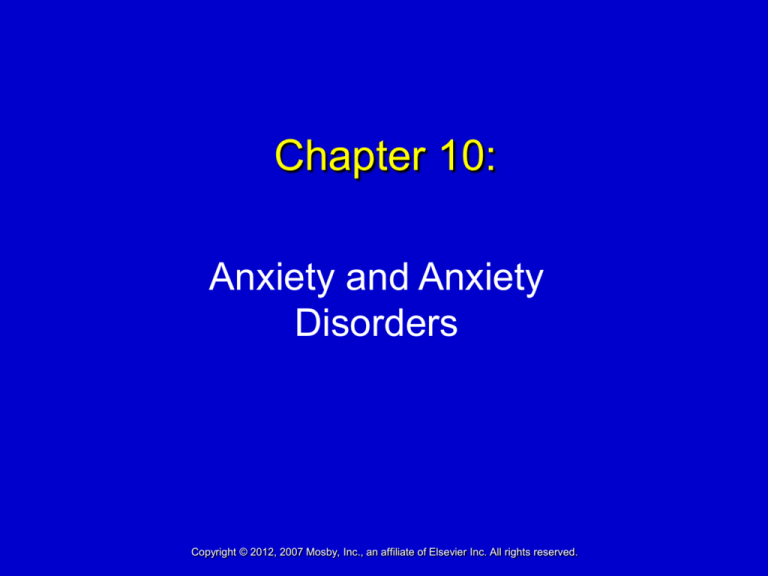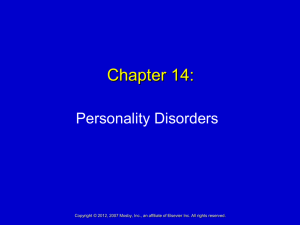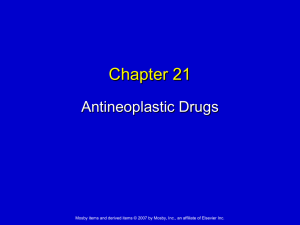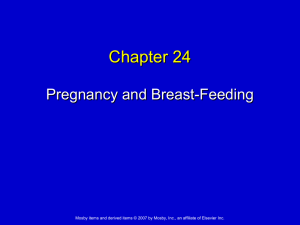
Chapter 10:
Anxiety and Anxiety
Disorders
Copyright © 2012, 2007 Mosby, Inc., an affiliate of Elsevier Inc. All rights reserved.
Anxiety
Function to warn of impending threat, conflict,
or danger
State of tension, dread, or impending doom
External influences of threat
Subjective
No identifiable object
Exists on a continuum
Copyright © 2012, 2007 Mosby, Inc., an affiliate of Elsevier Inc. All rights reserved.
2
When person receives danger
signal….
Fleeing
Controlling dangerous impulses
Freeze, do not act
Copyright © 2012, 2007 Mosby, Inc., an affiliate of Elsevier Inc. All rights reserved.
3
Defense Mechanisms
Primary method the ego uses to manage
anxiety
Unconscious
Protect ego
Copyright © 2012, 2007 Mosby, Inc., an affiliate of Elsevier Inc. All rights reserved.
4
Defense Mechanisms, cont’d
Humor
Sublimation
Suppression
Displacement
Dissociation
Repression
Devaluation
Denial
Projection
Splitting of self or image of others
Copyright © 2012, 2007 Mosby, Inc., an affiliate of Elsevier Inc. All rights reserved.
5
Stages of Anxiety
Mild
Moderate
Severe
Panic
Copyright © 2012, 2007 Mosby, Inc., an affiliate of Elsevier Inc. All rights reserved.
6
Clinical Presentations
Panic attack
Panic disorder
Phobias
Agoraphobia
Social phobia
Posttraumatic stress
disorder
Acute stress
disorder
Generalized anxiety
disorder
Obsessive
compulsive disorder
Copyright © 2012, 2007 Mosby, Inc., an affiliate of Elsevier Inc. All rights reserved.
7
Humanistic Nursing Theory
Basis: Existential theory, phenomenologic
method
An interactive process:
The client calls; the nurse responds.
The nurse is a participant, fully available to the
client.
Copyright © 2012, 2007 Mosby, Inc., an affiliate of Elsevier Inc. All rights reserved.
8
Additional Treatment Modalities
Biologic
Interventions
Pharmacologic
Interventions
Psychotherapy
Behavioral therapy
Cognitive behavioral
therapy
Psychologic first aid
Copyright © 2012, 2007 Mosby, Inc., an affiliate of Elsevier Inc. All rights reserved.
9
Etiologic Models for Anxiety
Biologic
Genetic
Psychosocial
Psychodynamic
Social theories
Copyright © 2012, 2007 Mosby, Inc., an affiliate of Elsevier Inc. All rights reserved.
10
Epidemiology
Prevalence
Age of onset
Cultural variance
Comorbidity
Copyright © 2012, 2007 Mosby, Inc., an affiliate of Elsevier Inc. All rights reserved.
11
Panic Attacks
Sudden onset
Physical symptoms of anxiety
Dread/doom/fear of death
Occur with:
Panic disorder
Social phobia
Simple phobia
Posttraumatic stress disorder (PTSD)
Copyright © 2012, 2007 Mosby, Inc., an affiliate of Elsevier Inc. All rights reserved.
12
Panic Disorder
Recent unexpected panic attacks
Concern (1 month) about additional attacks
Copyright © 2012, 2007 Mosby, Inc., an affiliate of Elsevier Inc. All rights reserved.
13
Panic Disorder with Agoraphobia
Anxiety about being where escape is difficult
Situations avoided/endured with anxiety
Not due to effects of a medical
condition/substance
Not better described by other mental disorder
Copyright © 2012, 2007 Mosby, Inc., an affiliate of Elsevier Inc. All rights reserved.
14
Specific Phobia
Marked, persistent fear
Excessive and unreasonable
Cued by presence/anticipation of specific
object/situation
Avoided or endured with anxiety
Distressed about having the phobia
Copyright © 2012, 2007 Mosby, Inc., an affiliate of Elsevier Inc. All rights reserved.
15
Social Anxiety Disorder
Marked, persistent fear of one or more social
or performance situations
Often exposes individual to scrutiny because
behavior may be embarrassing
Avoided or endured with anxiety
Treated with individual therapy and serotonin
selective reuptake inhibitors (SSRIs)
Copyright © 2012, 2007 Mosby, Inc., an affiliate of Elsevier Inc. All rights reserved.
16
Posttraumatic Stress Disorder
Traumatic event preceding symptoms
Individual response: fear, horror,
helplessness
Client often re-experiences event
Disturbing recollections
Feeling/acting as though event is reoccurring
Physiologic distress during reoccurrence
Physiologic reactivity to similar cues
Copyright © 2012, 2007 Mosby, Inc., an affiliate of Elsevier Inc. All rights reserved.
17
Posttraumatic Stress Disorder,
cont’d.
Avoidance of stimuli associated with the trauma
Numbing of general responsiveness
Estrangement, detachment
Restricted affect
Symptoms of increased arousal
Sleep disturbed
Irritability
Poor concentration
Exaggerated startle response
Copyright © 2012, 2007 Mosby, Inc., an affiliate of Elsevier Inc. All rights reserved.
18
Acute Stress Disorder
Different from PTSD:
Experiences these symptoms of dissociation:
numbing, detachment, dazed, derealization,
depersonalization, dissociative amnesia
Shorter time frame of development
Shorter duration of symptoms (2-30 days)
Not able to pursue a necessary task
Copyright © 2012, 2007 Mosby, Inc., an affiliate of Elsevier Inc. All rights reserved.
19
Generalized Anxiety Disorder
Excessive anxiety and worry
Occurring more days than not
At least 6 months duration
Presence of three of the following:
restlessness, edginess, fatigue, poor
concentration, irritability, muscle tension,
sleep disturbance
Anxiety and worry that interfere with normal
social and occupational functioning
Copyright © 2012, 2007 Mosby, Inc., an affiliate of Elsevier Inc. All rights reserved.
20
Obsessive Compulsive Disorder
Obsessions
Compulsions
Cannot be suppressed/ignored
Recognized as unwanted/unreasonable
Interferes with normal functioning
Etiology: trauma to basal ganglia/cortical
connections
Treatment: SSRIs
Copyright © 2012, 2007 Mosby, Inc., an affiliate of Elsevier Inc. All rights reserved.
21
Assessment
Eating and eliminating patterns
Tics, stuttering
Eye contact
Blushing
Affect related to roles/role problems in work,
finances, family, role strain
Copyright © 2012, 2007 Mosby, Inc., an affiliate of Elsevier Inc. All rights reserved.
22
Assessment, cont’d.
Culture/values
Coping strategies
Physical disability/motor dysfunction
Mental status
Orientation
Memory
Pain
Fears
Copyright © 2012, 2007 Mosby, Inc., an affiliate of Elsevier Inc. All rights reserved.
23
Useful Nursing Diagnoses
Anxiety
Ineffective coping
Interrupted family processes
Fatigue
Risk-prone health behavior
Risk for loneliness
Posttrauma syndrome
Copyright © 2012, 2007 Mosby, Inc., an affiliate of Elsevier Inc. All rights reserved.
24
Useful Nursing Diagnoses,
cont’d.
Powerlessness
Rape-trauma syndrome
Ineffective role performance
Impaired memory
Chronic low self-esteem
Social isolation
Spiritual distress
Copyright © 2012, 2007 Mosby, Inc., an affiliate of Elsevier Inc. All rights reserved.
25
Outcomes
Determined by client’s clinical manifestations
Clients will:
Demonstrate effective coping skills
Identify increasing anxiety
Identify when to call therapist
Take medications as prescribed
Copyright © 2012, 2007 Mosby, Inc., an affiliate of Elsevier Inc. All rights reserved.
26
Planning
Inpatient treatment being replaced by
outpatient treatment
Hospitalization: Client at risk for harm to self
or others
Copyright © 2012, 2007 Mosby, Inc., an affiliate of Elsevier Inc. All rights reserved.
27
Implementation
Assess own level of anxiety.
Recognize use of relief behaviors.
Teach:
To limit central nervous system (CNS) stimulants
To distinguish identifiable sources/
nonidentifiable anxiety-reducing strategies
Help build on familiar coping methods.
Copyright © 2012, 2007 Mosby, Inc., an affiliate of Elsevier Inc. All rights reserved.
28
Implementation, cont’d.
Help identify support persons
Give brief, directive verbal interactions
Structure calm environment
Assess grief/depression/suicidal ideation
Teach about medication regimen
Copyright © 2012, 2007 Mosby, Inc., an affiliate of Elsevier Inc. All rights reserved.
29
Treatment Modalities
Benzodiazepines
SSRIs
Fluoxetine, fluvoxamine (OCD)
Paroxetine (GAD, OCD, PTSD, social phobia,
panic disorder)
Sertraline (OCD, panic disorder, PTSD)
Venlafaxine (GAD)
Clomipramine (body dysmorphic disorder)
ECT
Copyright © 2012, 2007 Mosby, Inc., an affiliate of Elsevier Inc. All rights reserved.
30
Treatment Modalities, cont’d.
Psychotherapy
Behavioral therapy
Cognitive behavioral therapy
Copyright © 2012, 2007 Mosby, Inc., an affiliate of Elsevier Inc. All rights reserved.
31
Evaluation
Measurable outcomes necessary
Rating scales
Hamilton Anxiety Scale
Yale-Brown Obsessive-Compulsive Scale
Copyright © 2012, 2007 Mosby, Inc., an affiliate of Elsevier Inc. All rights reserved.
32





